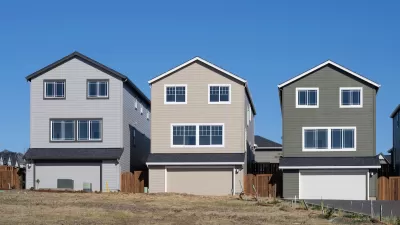Recent analysis shows that Americans are less willing to pay extra for large houses. It's information best viewed skeptically, but it's also worth considering why this trend has finally, semmingly swung the other way.

Joe Cortright continues an ongoing crusade to elucidate the facts about the creation and consumption of McMansions in the housing market.
Cortright's commentary follows a round of "downbeat" stories about the demand for McMansions. Stories from Bloomberg and the Chicago Tribune followed the lead of Trulia's Ralph McLaughlin, who compared price trajectories of 3,000- to 5,000-square-foot homes built between 2001 and 2007 with all other homes in each metropolitan area. "McLaughlin found that since 2012, the premium that buyers paid for these big houses fell pretty sharply in most major metropolitan markets around the country," explains Cortright. "Overall, the big house premium fell from about 137 percent in 2012 to 118 percent this year."
According to Cortright, the falling premiums for McMansions might have to do with the aging process: "Like new cars, McMansions may have their highest value when they leave the showroom…" But according to Cortright, another factor could also be working against the McMansion: as demand for urban, walkable areas has increased, demand for McMansions built on the periphery of metropolitan areas has not gone unscathed.
Finally, says Cortright, the market factors that drove the boom in McMansions in the bubble years just no longer exist.
The bad news for the McMansion market is new—Planetizen was picking up stories that reported of a renewed trend toward houses of larger and larger sizes around the United States as recently as July of 2016 (and also in June 2014). Cortright, however, offered a dissenting opinion about how the real estate's data skewed toward a false portrayal of McMansion dominance in the market.
FULL STORY: McMansions Fading Away?

Alabama: Trump Terminates Settlements for Black Communities Harmed By Raw Sewage
Trump deemed the landmark civil rights agreement “illegal DEI and environmental justice policy.”

Study: Maui’s Plan to Convert Vacation Rentals to Long-Term Housing Could Cause Nearly $1 Billion Economic Loss
The plan would reduce visitor accommodation by 25% resulting in 1,900 jobs lost.

Planetizen Federal Action Tracker
A weekly monitor of how Trump’s orders and actions are impacting planners and planning in America.

Waymo Gets Permission to Map SF’s Market Street
If allowed to operate on the traffic-restricted street, Waymo’s autonomous taxis would have a leg up over ride-hailing competitors — and counter the city’s efforts to grow bike and pedestrian on the thoroughfare.

Parklet Symposium Highlights the Success of Shared Spaces
Parklets got a boost during the Covid-19 pandemic, when the concept was translated to outdoor dining programs that offered restaurants a lifeline during the shutdown.

Federal Homelessness Agency Places Entire Staff on Leave
The U.S. Interagency Council on Homelessness is the only federal agency dedicated to preventing and ending homelessness.
Urban Design for Planners 1: Software Tools
This six-course series explores essential urban design concepts using open source software and equips planners with the tools they need to participate fully in the urban design process.
Planning for Universal Design
Learn the tools for implementing Universal Design in planning regulations.
Caltrans
Smith Gee Studio
Institute for Housing and Urban Development Studies (IHS)
City of Grandview
Harvard GSD Executive Education
Toledo-Lucas County Plan Commissions
Salt Lake City
NYU Wagner Graduate School of Public Service





























